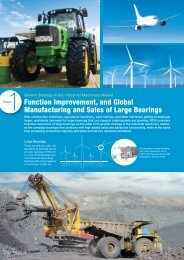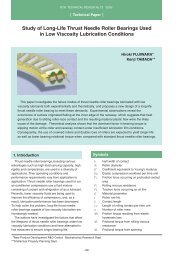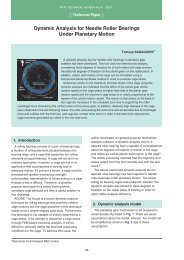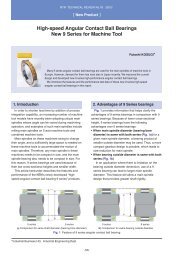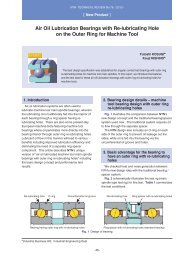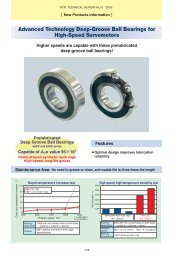Special Issue; Products for Industrial Machinery - NTN
Special Issue; Products for Industrial Machinery - NTN
Special Issue; Products for Industrial Machinery - NTN
Create successful ePaper yourself
Turn your PDF publications into a flip-book with our unique Google optimized e-Paper software.
<strong>NTN</strong> TECHNICAL REVIEW No.742006<br />
5. Conclusion<br />
<strong>NTN</strong> has per<strong>for</strong>med a systematic series of<br />
experiments <strong>for</strong> carbonitriding with JIS-SUJ2 high<br />
carbon chromium bearing steel in an attempt to clarify<br />
the nitrogen penetration mechanism associated with<br />
this material. Also, assuming that the nitrogen<br />
penetration mechanism is similar to the carbon<br />
penetration mechanism, <strong>NTN</strong> has established a<br />
method <strong>for</strong> predicting nitrogen concentration<br />
distribution based on a series of experiments. The<br />
findings are summarized as follows:<br />
1) The nitrogen penetration amount increases<br />
directly with an increases in the partial pressure<br />
of undecomposed NH3.<br />
2) The nitrogen penetration amount increases<br />
directly with decreases in both carbon activity<br />
ac* and H2 partial pressure.<br />
3) <strong>NTN</strong> has established a method <strong>for</strong> predicting<br />
the nitrogen concentration distribution of JIS-<br />
SUJ2 material. This method reflects<br />
considerations <strong>for</strong> the partial pressure of<br />
undecomposed NH3, the carbon activity ac*, H2<br />
partial pressure and the diffusion coefficient<br />
that is dependent on nitrogen concentration.<br />
4) <strong>NTN</strong> confirmed that, <strong>for</strong> various carbonitriding<br />
atmospheres, the predicted steel nitrogen<br />
concentration distribution (using <strong>NTN</strong>’s method<br />
<strong>for</strong> determining nitrogen concentration<br />
distribution) closely matches actual data<br />
obtained through EPMA analysis.<br />
References<br />
1) N. Tsushima: SAE Technical Paper Series (1986)<br />
860725 (in Japanese)<br />
2) S. Narita and K. Yokose: “Effects of the nitriding potential<br />
caused by surface nitrogen concentration on various<br />
types of carbonitrided case hardening steel,” Japan<br />
Society <strong>for</strong> Heat Treatment 61st Lecture Series<br />
Preliminary draft (2005) 5 (in Japanese)<br />
3) C. Ohki, M. Kawakita: “Effects of carbon activity from the<br />
carbonitriding process on high-carbon steel,” Japan<br />
Society <strong>for</strong> Heat Treatment 62nd Lecture Series<br />
Preliminary draft (2006) 5 (in Japanese)<br />
4) C. Ohki, M. Kawakita: “Effects of base gas partial<br />
pressure from the carbonitriding process on high-carbon<br />
steel,” Japan Society <strong>for</strong> Heat Treatment 62nd Lecture<br />
Series Preliminary draft (2006) 17 (in Japanese)<br />
5) Editorial Committee of the Society of Chemical Engineers<br />
Japan: Chemical Engineering Handbook, Maruzen (1950)<br />
64 (in Japanese)<br />
6) R.Collin, S.Gunnarson, and D.Thulin: "Influence of<br />
Reaction Rate on Gas Carburizing of Steel in a CO-<br />
H2-CO2-H2O-CH4-N2 Atmosphere, "Journal of The Iron<br />
and Steel Institute, (1972), 777<br />
7) F. Neumann and U.Wyss: "Thermodynamische<br />
Grundlagen zum indirekten Messen des C-Pegels, "<br />
H.T.M., vol.49, No.4, (1994) 255 (in German)<br />
-52-



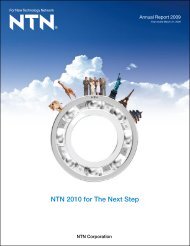
![[New Product] Unit Products for Office Equipment - NTN](https://img.yumpu.com/27154451/1/184x260/new-product-unit-products-for-office-equipment-ntn.jpg?quality=85)
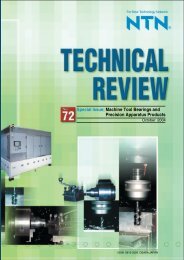
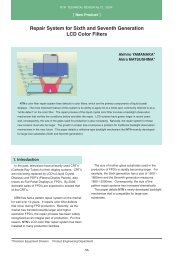
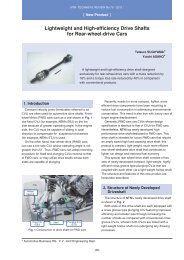
![[New Product] Development of Oil-impregnated Sintered ... - NTN](https://img.yumpu.com/27154427/1/184x260/new-product-development-of-oil-impregnated-sintered-ntn.jpg?quality=85)

